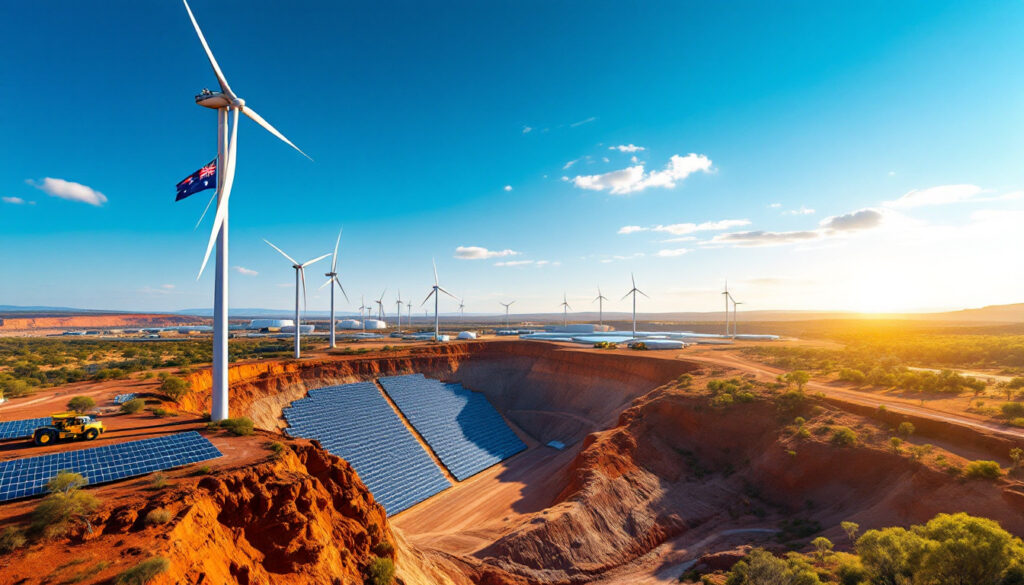Renewables Adoption in Mining: Transforming Australia's Mining Sector
Australia's mining sector is undergoing a profound transformation as renewable energy integration accelerates, driven by decarbonization mandates and economic incentives. Gold Fields' St Ives mine exemplifies this shift, targeting 73% renewable electricity by 2026 through hybrid wind-solar systems. Despite structural challenges, 30% of Australian mines now utilize renewables, with adoption rates surging since 2023. This report explores the drivers, barriers, and innovations reshaping the industry's approach to green transformation strategies.
How Are Renewables Reshaping Australia's Mining Industry?
The Current State of Renewables in Australian Mining
Australia's abundant solar (avg. 58 million PJ/year) and wind resources (40 GW potential coastal capacity) position it as a global leader in mining-sector renewables. Hybrid systems combining solar PV, wind turbines, and lithium-ion batteries now power 15-40% of remote operations, reducing diesel reliance by up to 80%. However, intermittency remains a hurdle, with operations requiring 20-50% battery storage relative to peak load. Gold Fields' St Ives project—12 MW solar farm paired with 8 MW wind—avoids 45,000 tCO2/year, showcasing scalable solutions for the mining digital transformation.
Key Drivers for Renewable Energy Adoption
-
Cost Reduction: Hybrid systems cut energy costs by 15-40% versus diesel, with 3-7-year payback periods.
-
Policy Incentives: ARENA grants and Renewable Energy Target schemes subsidize 30-50% of project CAPEX.
-
ESG Pressures: 85% of ASX-listed miners now report Scope 2 emissions, with 60% targeting net-zero by 2035.
What Challenges Are Mining Companies Facing in Renewable Implementation?
Technical Barriers to Renewable Adoption
Intermittency management remains critical; St Ives uses 48 MWh battery storage to stabilize 20 MW peak loads. Remote sites face grid connectivity costs exceeding $200/km, making off-grid solutions imperative. Over 75% of mines require custom engineering for renewable integration due to unique geographies and specific operational requirements.
Financial Considerations
Upfront CAPEX for solar-wind-battery systems averages $500-$800/kW, though opex savings offset this within 5 years. Mine life variability complicates ROI; projects under 10-year lifespans struggle to justify investments. Many companies now rely on comprehensive mining feasibility studies to determine the economic viability of renewables adoption in mining operations.
Regulatory and Policy Framework
WA's Environmental Protection Act 1986 mandates renewable feasibility studies for new mines, while Queensland's Zero Net Emissions Act 2050 imposes carbon tariffs on diesel. Permitting delays average 18 months nationally, hindering rapid deployment of new renewable energy infrastructure.
What Makes Gold Fields' St Ives Project a Potential Blueprint?
St Ives Renewable Energy Project Details
The $112 million initiative combines 12 MW solar, 8 MW wind, and 48 MWh Tesla batteries, meeting 73% of 89 GWh annual demand. Predictive AI algorithms optimize energy flow, reducing diesel backup usage to <10%. According to recent research on renewable energy in mining, this project represents one of the most advanced implementations in Australia.
Innovative Approaches at St Ives
-
Hybrid Microgrids: Decentralized control systems balance loads across processing plants.
-
Contract Structuring: Power Purchase Agreements (PPAs) with Nexif Energy lock in rates at $0.09/kWh, 40% below grid averages.
Lessons for Industry-Wide Implementation
St Ives demonstrates that hybrid systems can achieve reliability metrics of 99.7% uptime while significantly reducing carbon emissions. The project's phased implementation approach—starting with solar before adding wind and storage—provides a risk-mitigation model for other operations looking to implement digital twins in mining.
How Is Electrification Supporting Mining's Renewable Transition?
The Electrification Movement in Australian Mining
Battery-electric vehicles (BEVs) like Sandvik's Z50 trucks reduce energy demand by 30% versus diesel counterparts, amplifying renewable ROI. Currently, 22% of underground operations have begun BEV adoption programs, primarily in gold and copper mines where ventilation savings provide additional benefits.
Key Electrification Technologies
Trolley-assist systems on haul roads cut energy use per kg of ore by 15%, while vehicle-to-grid (V2G) technology repurposes BEV batteries as storage during downtimes. Wireless charging infrastructure deployed at strategic locations minimizes operational disruptions while maximizing renewable utilization.
Synergies Between Electrification and Renewable Energy
Smart load management systems prioritize charging during peak renewable generation periods, creating a synergistic relationship between mobile equipment and power infrastructure. One mine reported 35% higher renewable utilization rates after implementing time-of-use charging protocols, as highlighted in a comprehensive study on mining industry transformation.
What Role Do Green Metals Play in Australia's Mining Future?
Australia's Green Metals Strategy
Geoscience Australia's $75M critical minerals mapping initiative has identified 12 new lithium deposits, bolstering Australia's 55% global lithium market share. The government's Critical Minerals Strategy aims to triple processing capacity by 2030, retaining value onshore.
Key Green Metals in Focus
Solar-powered processing plants, like Pilbara Minerals' Pilgangoora, reduce embodied carbon in lithium hydroxide by 60%. New techniques for innovative lithium extraction use 40% less energy than conventional methods, further enhancing sustainability credentials.
Creating Sustainable Supply Chains
Blockchain-based traceability systems now track 35% of Australian lithium from mine to battery, commanding premium pricing in European markets. Circular economy initiatives recover 85% of battery metals from mining equipment, creating closed-loop systems.
How Is Technology Accelerating Sustainable Mining Practices?
AI Applications in Mining Sustainability
AI-driven comminution at Rio Tinto's Gudai-Darri mine slashes energy use by 20% via real-time ore hardness adjustments. Machine learning models predict renewable generation with 92% accuracy, optimizing battery dispatch and minimizing diesel consumption.
Automation and Robotics Advancements
WA's $30M Automation Testbed develops renewable-powered drones for site monitoring, cutting survey costs by 40%. Autonomous haul trucks operate at consistent speeds, reducing energy consumption by 15-25% compared to human-operated vehicles.
Digital Twins and Simulation Technologies
Virtual models simulate over 10,000 energy scenarios before physical implementation, reducing commissioning time by 60%. Energy flow optimization through digital twins improves renewable utilization by predicting consumption patterns and adjusting generation accordingly.
What Support Is Needed for Wider Renewable Adoption?
Policy and Regulatory Recommendations
Proposed reforms include federal tax incentives covering 50% of storage CAPEX and standardized inter-state permitting protocols. A national "Mining Renewables Roadmap" would align state regulations, reducing compliance costs by an estimated 30%.
Industry Collaboration Opportunities
Industry consortia like the Renewable Mining Alliance share R&D costs, halving project lead times. Collaborative microgrids serving multiple operations have demonstrated 25% higher return on investment through shared infrastructure.
Investment and Funding Models
Green bonds specifically for mining renewables reached $1.2B in 2023, with oversubscription rates of 300%. Innovative financing structures including equipment-as-a-service models remove CAPEX barriers, accelerating adoption for mines with shorter lifespans.
Conclusion
Australia's mining sector is transitioning from diesel dependency to renewable resilience, with St Ives proving technical and economic viability. Scaling this model requires addressing CAPEX barriers through innovative financing and policy coherence. As AI and electrification mature, renewables adoption in mining could power 80% of mines by 2035, securing Australia's position as a sustainable resources leader.
Seeking Opportunities in Mining's Green Revolution?
Discover high-potential ASX mining companies at the forefront of renewable adoption with real-time alerts from Discovery Alert's proprietary Discovery IQ model, providing actionable investment insights ahead of the market. Explore more about turning major mineral discoveries into substantial returns by visiting our dedicated discoveries page and begin your 30-day free trial today.




